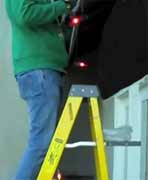
FRIDAY, Oct. 9, 2015 (HealthDay News) — Fall clean-up often means it’s time to drag out your ladder and rake. But what may seem like an easy task can lead to serious injury if you don’t take proper precautions.
“Never underestimate the task at hand while cleaning. Even the most mundane or simple chores can cause strain, injury, or even a fall if not done correctly. For instance, when using a ladder, never stand on the top rung,” Dr. Patrick Osborn, an American Academy of Orthopaedic Surgeons (AAOS) spokesman and orthopedic trauma surgeon, said in an AAOS news release.
Last year in the United States, more than 500,000 ladder-related injuries and more than 42,000 rake-related injuries were treated by doctors, the AAOS said.
To stay safe while getting your yard and house clean, the AAOS offers some advice.
Use a rake that is suitable for your height and weight, and have equipment such as leaf blowers serviced before you use them this fall.
Inspect ladders for loose screws, hinges or rungs, and clean off any mud or liquids. Use the right ladder for the job. Use a step stool or utility ladder when working at low or medium heights, such as washing windows inside the home. The AAOS recommends using an extension ladder when working in high locations, such as cleaning the gutters.
When working on a ladder, don’t wear leather-soled shoes because they’re slippery. Be sure the soles of your shoes are free of debris or greasy, oily or wet substances. Wear pants with legs that aren’t too wide or long, the AAOS said.
Don’t use ladders in rain, wind, snow, ice or other conditions that increase the risk of slipping and falling. Have someone hold the ladder, stay in the center of the ladder, and always hold the side rails with both hands. The AAOS advises that only one person should be on the ladder at a time.
Place the ladder on a firm, level surface and engage the ladder locks or braces before you climb it. If you’re outside, be sure the ladder will not come into contact with electrical wires, tree limbs or any other obstructions.
When using an extension ladder, the bottom of the ladder should be one foot away from the wall for every four feet of height. (For example, if the ladder touches the wall 16 feet above the ground, the base of the ladder should be four feet from the wall). The upper and lower sections of the ladder should overlap to provide stability. If you’re climbing onto a roof, the ladder should extend at least three feet above the rooftop, the AAOS said.
Position the ladder close to where you’re working. Over-reaching or leaning too far to one side can cause you to lose your balance and fall.
More information
The American College of Emergency Physicians offers injury prevention advice.
Copyright © 2025 HealthDay. All rights reserved.

